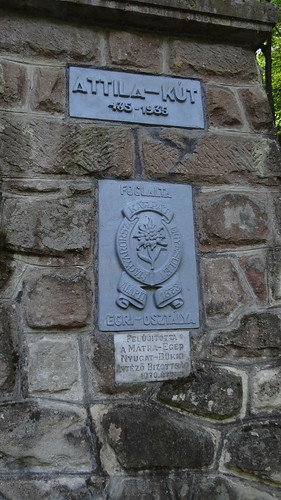René Primevère Lesson, it seems, was given to bestowing the names of barbarian chieftains on his birds. In 1831, for example, he renamed Gmelin’s Muscicapa spadiceus—first described by Latham as the Yellow-rumped Fly-catcher—Atilla, identified rather sensationally by Jobling as the “ruler of the Hunnish tribes that ravaged Europe in the fifth century, who reve[l]ed in the appelation ‘Scourge of God’.”
Attila monument in Hungary’s Bükk Hills
As usual, Lesson doesn’t fill us in on his inspiration for this odd name, but if we are to trust the all-knowers of the all-knowing internet, it was simply an allusion to this big tyrannid’s aggressive nature.

There’s more to the joke, I think. Long discredited scientifically, one of the great naturalist’s lesser-known works, the Histoire naturelle de l’homme, may still offer a clue to this puzzle. In his discussion of the historical Huns and their putative descendants, the Magyars, Lesson quotes the fifth-century diplomat Priscus, who had served in a Roman delegation to the Hunnish court and who knew Attila personally:
Attila was short, with a broad chest, small eyes, a sparse beard, a flat nose, and a dark complexion.
In his authoritative description of the new avian genus, Lesson remarks on the bird’s bill, “broadened at the base,” its “bristly mouth,” and its “dusky olive-green” plumage. Is it just possible that he imagined a physical resemblance between the Hunnish king and his feathered namesake?
There is another hint in the name Charles Lucien Bonaparte assigned in 1857 to a genus of west African bulbuls. First described by Swainson thirty years before, the type specimen had been acquired from Sierra Leone by William Bullock, whose entire collection Swainson purchased and slowly worked through.
Swainson was excited by Bullock’s bulbul:
The very remarkable bird we are about to describe is, to the ornithologist, one of the most interesting contained in this volume…. To Dasycephala it is related by its lengthened, straight, and abruptly hooked bill; by a few incurved setaceous feathers and hairs over the nostrils, by the length of the tarsus and of the middle toe; and, by the great inequality between the lateral toes.
Of those characters, Swainson was most impressed by the “feathers and hairs” at the nares, and he gave his skin the English name African Bristle-bill, known today as the Red-tailed Bristlebill.
When Bonaparte came along, he rejected Swainson’s assignment of the species to Dasycephalus, deciding that it was sufficiently distinct to merit its own genus. He named it Bleda,
ainsi nommé du frère d’Attila,
“so called after the brother [and co-regent] of Attila.”
Maybe Lesson wasn’t joking, but Bonaparte most surely was.


